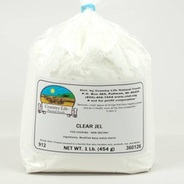
The professional bakers choice is ClearJel®. It comes in two types one made for cooking with the filling, also good for canning pie fillings. The second type is Instant ClearJel® used for fillings that are not cooked like a fresh strawberry pie. Both types of ClearJel®, are available thru the Co-Op, at a very reasonable price.
Advantages of ClearJel®
- ClearJel® is clear in color when cooked.
- It has excellent stability.
- ClearJel® remains smooth.
- It prevents liquid separation and curdling after foods have been frozen.
- Custard and pudding pie fillings can be frozen with excellent results.
ClearJel® is a modified cornstarch that works well with acidic ingredients, tolerates high baking temperatures, and doesn't cause the pie fillings to "weep" during storage. It's an especially good choice if you're canning homemade pie fillings, since it doesn't begin thickening until the liquid begins to cool. This allows the heat to be more evenly distributed within the jar during processing. Even using the maximum amount of ClearJel® will result in a pleasing, “soft” gel, unlike the stiff, hard gel you’d get with gelatin.
How to Use Regular ClearJel®
ClearJel® comes in a powdered form, just like cornstarch. When making a fruit filling, start by mixing the thickener with the sugar and spices in the recipe. Not only does this ensure the thickener reaches every part of the filling, it prevents it from clumping. Then sprinkle the mixture over the fruit and put in the prepared pie crust and bake. Every fruit is a bit different so look at the fruit chart below to get an idea of how much you should add. The fruit filling thickens as it cools, so don't judge your pie hot out of the oven, wait until it's cooled to room temperature.
Pie Chart
Apple Pie 1/2 tsp per cup of fruit
Need the least amount of thickener, since apples are less watery. They are also high in pectin, which helps them set up as filling.
Berry Pie 1 T per cup of fruit
Have a lot of liquid, and release even more if they've been frozen. Blueberries have a lot of pectin, so will need a little less if cooked with lemon juice and sugar.
Cherry Pie 2 1/2 tsp per cup of fruit
Fresh cherries will need slightly less thickener than canned or frozen.
Peach and Stone Fruits 2 tsp per cup of fruit
Don't have quite as much pectin as apples, also have more liquid.
Strawberry and Rhubarb 2 tsp per cup of fruit
Another juicy combination; needs as much thickener as berries do.
Frozen fruit releases more juice than fresh. When baking pie with frozen fruit or berries, increase the thickener by 1/4 teaspoon per cup of fruit or berries.
Lattice-top or crumb-top fruit pies need less thickener, as more moisture evaporates from open-top pies as they bake. When baking a lattice or open-top pie, reduce thickener by 1/4 teaspoon per cup of filling (1/2 teaspoon per cup for Instant ClearJel® ).
Equivalents
1 tablespoon = 4 grams
1 pound ClearJel® = 3 cups ClearJel®
1 tablespoon cornstarch = 1 1/2 tablespoon ClearJel®
2 tablespoon flour or tapioca= 1 tablespoon ClearJel®
ClearJel® it is stable enough to be frozen. You can freeze an unbaked pie and then bake it later without the possibility of the filling becoming runny.
Instant ClearJel®
Is similar but different, Instant ClearJel® will thicken a little bit more when heated. Just like the regular ClearJel® it is also heat and acid resistance. Instant ClearJel® has excellent cold temperature stability and storage which makes it good for refrigerated and frozen pies. Do not use Instant ClearJel® for canning your pie fillings. It is only good for one-time heating.
How to Use Instant ClearJel®
Always mix ClearJel® with the sugar in the recipe before using to prevent clumping, then add to the fruit. You do not need to cook the filling. Instant ClearJel® will thicken fruit without baking. It will continue to thicken slightly about 15% thicker from day 1 to day 2.
To make a delicious fresh berry pie, cut up the berries, and sprinkle it with half the sugar called for in the recipe. Let the mixture sit for about 20 minutes, until the juices start to collect in the bottom of the bowl. Mix the instant ClearJel® with the remaining sugar, and stir it with the fruit. Gently pour the thickened filling into a cooled pre-baked pie shell. You may top with whipped cream. Instant ClearJel® will give your filling a smooth texture without being gummy when fully hydrated. Instant ClearJel®– Is good for pies but not recommended for canning.
Storage
Store product in an airtight, moisture-proof container. Kept cool and dry it will last for one year.
Sources:
kingarthurflour.com
www.cooksinfo.com
www.everythingpies.com
 RSS Feed
RSS Feed
